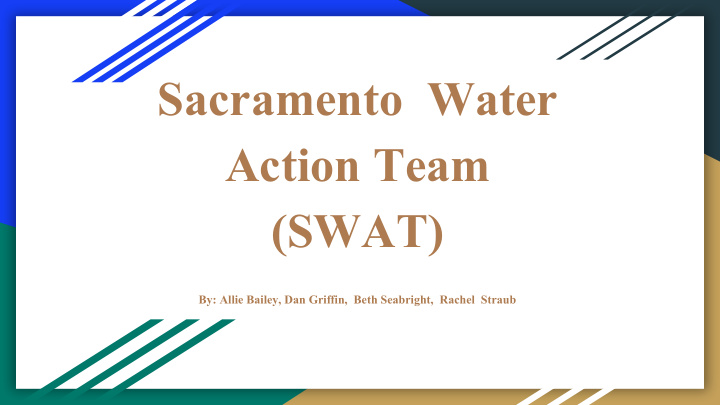



Sacramento Water Action Team (SWAT) By: Allie Bailey, Dan Griffin, Beth Seabright, Rachel Straub
Geography ● Originates from the mountains of Northern California and Lake Shasta, Upper Sacramento River, and Pit River ● Much of the river and tributaries has been altered from historic paths due to damming for hydroelectric power ● The largest population area of the watershed is in the city of Sacramento ● Numerous canyons can be found carved throughout it’s path Hydrology in Sacramento River Basin http://www.sacriver.org/aboutwatershed/roadmap/sacram ento-river-basin
Background and History ● Largest river and watershed system in California ● Drains into San Francisco Bay ● Southernmost run for chinook salmon in US ● Now provides drinking water for residents of Northern and Southern California, and serves as a vital supply of water for California’s massive agricultural industry
The Gold Rush and Its Impacts ● Gold was discovered in the river in 1848 ● After panning exhausted the supply of gold that could be collected that way hydraulic mining was introduced ● Mercury was used to separate the gold from impurities then collect it ● This caused the introduction of mercury to the river and surrounding tributaries ● In addition, the production of mercury resulted in mercury vapor entering the atmosphere and subsequently the water cycle ● Due to bioaccumulation, mercury has now built up in the fatty tissue of aquatic organisms
Policies and Governance ● Governance of the Sacramento River is controlled at the federal level by the EPA Region 9 office ● At the state level, management is controlled by California Environmental Protection Agency, or CalEPA, the state department in charge of environmental affairs ● The Sacramento River Flood Project was established by the federal government in 1917 to control excess floodwaters ● The Central Valley Project was established by the U.S. Bureau of Reclamation in 1933 to irrigate 3 million acres of land in the Sacramento River Valley/San Joaquin River Valley ● In 1960, California began the State Water Project, which was a plan to facilitate the transportation of water to Southern California. This was carried out through the construction of dams and channels which mostly took water out of the Sacramento River watershed
Mission Statement T To improve water quality in and along the Sacramento River Basin by reducing agricultural pollution, slowing erosion, and spreading awareness of the dangers of consuming aquatic life that contains mercury by 2028. ogh improve water quality in and along the Sacramento Basin by reducing agricultural pollution, slowing erosion, and spreading awareness of the dangers of consuming aquatic life that contains mercury by 2028.
Problem 1: Agricultural Pollution Issue: Agricultural pollution causes aquatic life toxicity and domestic supply impacts in the Sacramento Valley Solutions: ● increasing existing efforts such as cover crops, buffers, and conservation tillage ● applying fertilizers in the proper amount, at the right time of year and with the right method ● keeping animals and their waste out of streams and rivers
Problem 2: Rising Mercury and Methylmercury Levels in Aquatic Life Issue: Due to the California Gold Rush high levels of mercury have ended up in the Sacramento River Basin. Solutions: ● Majority of removal and remediation is being handled by state and private sources ● Main focus is to spread awareness of the danger of consuming aquatic life ● Educate residents to avoid consuming potentially contaminated species ● Encourage catch and release ● Spread awareness through social media push, flyers, and handouts
Problem 3: Accelerated Erosion of Stream Banks and Channels Issue: Humans activities such as gravel mining, pollution, riparian vegetation removal, flood control, and flow regulation have changed bank composition, bank erosion, river length, depth, and width, as well as floodplain deposition. Some erosion efforts cause further negative impacts to wildlife. Solutions: ● Pilot studies using various stabilization techniques and multi-year follow-up studies to determine effectiveness and impacts of the various technologies ○ J-hook rock vanes and willow planting along an eroding riverbank ○ Rock toe with brush layering on the bank and introduction of local plants ○ Placement of root wads, revegetation riprap
Goals ● Increasing existing efforts such as cover crops, buffers, and conservation tillage ● Applying fertilizers in the proper amount, at the right time of year and with the right method ● Keeping animals and their waste out of streams and rivers ● Spreading awareness of best practices for agriculture ● Decreasing the amount of fish and shellfish caught and consumed ● Repairing stream banks damaged by erosion and preventing future erosion
Recommend
More recommend